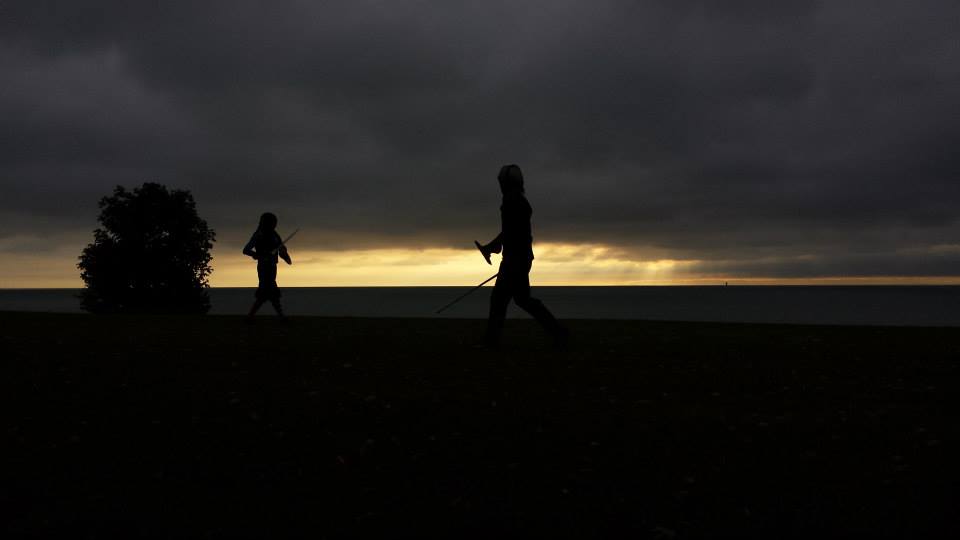For the past many years my focus in the pursuit of Historical European Martial Arts has been very much on safely exploring the “martial” aspect. I want to get as close to the original martial art as I realistically can without actually putting myself, my training partners, or my students in mortal danger. Yet that is a difficult thing to do. Without treading the line between life and death it is difficult to not introduce excessive amounts of fallaciousness into your practice. Here are some of the ways that I attempt to triangulate on the authentic art by exploring as many waypoints around “true” martial practice as I can.
Spar with Intent
To really understand your art you need to put it into a combative context, and when you’re there, you need to practice it as authentically as possible. In our school, we govern our martial practice with two tenets: Proper Arms and Proper Respect. In a nutshell, this means we use simulators that are as close to the historical weapons as we can get without their being sharp or pointed, but we still respect those weapons as if they are deadly, instead of dull. You can read more about this in an article I wrote in 2013: A Comparison of Historical Music to Historical Swordplay.
Participate in Tournaments or other Pressure Environments
The tournament environment is governed by rules, focused on winning (not surviving), and is prescriptive of equipment and environment. All of this is nothing like actual fighting. However, tournaments can provide psychological pressure, motivation to act at a high level, and a degree of intensity that is often difficult to create in any other place. These are all essential parts of good martial training. They can also be a lot of fun. The important thing for maintaining the “martial” in your art is to ensure that tournaments are only one of the waypoints on your martial map, and that you are mindful of your personal goals when you go into them.
Practice with Sharps
I don’t mean trying to kill your friends, simply spending time with sharp swords doing cutting, or slow blade interaction exercises. If your goal is martial, you need to understand how the real tools really act. The previously linked article has more on this.
Connect with Sources and Contemporary Texts
How does what you’re doing relate to the manuals and stories written down by people who were really living and dying by the sword? In your training environments are you reproducing some of the exemplars naturally? It’s easy to drill a particular action from a manual in class, but if you are truly internalizing and authentically practicing that art, many of those techniques should be expressing themselves dynamically within combat (provided your combat is governed martially and not simply by what scores points). If techniques from the sources you study from are not being reliably expressed, why not?
Explore Different Contexts
Context is an essential part of exploring the full boundaries of your martial practice. It tests the understanding of the underlying principles of that art. Some techniques that we see historically don’t make sense in tournaments or duels, so it is rare to see them there. Some techniques make the most sense against multiple opponents, or in situations where one opponent is outmatched by another, or where backing up is not an option.
So, where should your martial art be useful? Is it an art for self-defence? For tournament? For battlefield survival? For duelling?
How adaptable is your art? Do you need to be able to deal with mismatched weapons? Mismatched styles? Variable terrain?
Bringing different environments, handicaps, and asymmetries into your training is important to truly understanding the full dimensions of your art.
Beyond physical contexts, many cultural contexts have a significant impact on the techniques of an art. To get a modern view of how this might have impacted our forebears, this podcast by Malcolm Gladwell explores why smart people do dumb things for cultural reasons.
I encourage you to take some time and consider the goals for your art and determine if your training environment incorporates the waypoints it needs to move toward those goals, while maintaining the health and safety of both you and your training partners.
Update on the October Instructor Intensive
A few different people have asked me this week if the October 17th to 21st instructor intensive is useful for people who are not currently, or necessarily planning, to be instructors. It most certainly is.
The intensive is 40 hours of technical instruction focused on our level 1 and level 2 material for Italian rapier and longsword. Our topics include:
- Posture, movement, and the body mechanics of powerful structure.
- Blade control and responsiveness in the crossing.
- How to attack and defend from all guards.
- Strategy in the wide and narrow play.
- Grappling and disarms.
- Fencing theory for combative analysis, coaching, and strategy.
The 10 hours of methodology is not only relevant to teachers but to anyone who wants to improve how they learn. Our topics include:
- How to maximize skill retention.
- Designing effective drilling environments.
- Development of tactical exercises to bridge skills from lesson to combat.
- Sparring games and varied sparring environments to create great fighters.
- How to usefully apply historical sources.
This week is an excellent opportunity to get hands-on time deepening your understanding and effectiveness with an art you love. And afterward, we’ll be directly involved for the next eight months to help you get even better.
